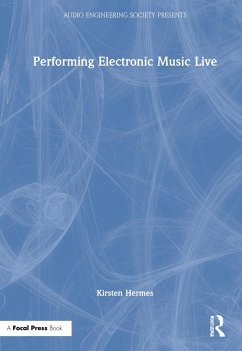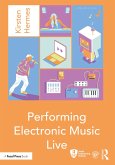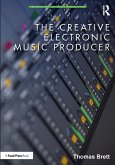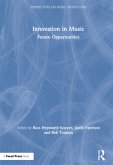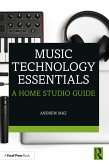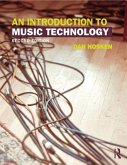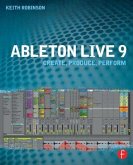Kirsten Hermes
Performing Electronic Music Live
Kirsten Hermes
Performing Electronic Music Live
- Gebundenes Buch
- Merkliste
- Auf die Merkliste
- Bewerten Bewerten
- Teilen
- Produkt teilen
- Produkterinnerung
- Produkterinnerung
This comprehensive book lays out the conceptual approaches, tools and techniques for performing electronic music, from DJing, DAWs, MIDI controllers, traditional instruments, live sound design, hardware setups, custom software and hardware to live visuals, venue acoustics and live show promotion.
Andere Kunden interessierten sich auch für
![Performing Electronic Music Live Performing Electronic Music Live]() Kirsten HermesPerforming Electronic Music Live71,99 €
Kirsten HermesPerforming Electronic Music Live71,99 €![The Creative Electronic Music Producer The Creative Electronic Music Producer]() Thomas BrettThe Creative Electronic Music Producer38,99 €
Thomas BrettThe Creative Electronic Music Producer38,99 €![Innovation in Music Innovation in Music]() Innovation in Music154,99 €
Innovation in Music154,99 €![Music Technology Essentials Music Technology Essentials]() Andrew MazMusic Technology Essentials41,99 €
Andrew MazMusic Technology Essentials41,99 €![An Introduction to Music Technology An Introduction to Music Technology]() Dan HoskenAn Introduction to Music Technology78,99 €
Dan HoskenAn Introduction to Music Technology78,99 €![Ableton Live 9 Ableton Live 9]() Keith Robinson (Lecturer at New York University, USA, specializingAbleton Live 9104,99 €
Keith Robinson (Lecturer at New York University, USA, specializingAbleton Live 9104,99 €![Mastering Electronic Dance Music Mastering Electronic Dance Music]() Alexandra BartlesMastering Electronic Dance Music49,99 €
Alexandra BartlesMastering Electronic Dance Music49,99 €-
-
-
This comprehensive book lays out the conceptual approaches, tools and techniques for performing electronic music, from DJing, DAWs, MIDI controllers, traditional instruments, live sound design, hardware setups, custom software and hardware to live visuals, venue acoustics and live show promotion.
Hinweis: Dieser Artikel kann nur an eine deutsche Lieferadresse ausgeliefert werden.
Hinweis: Dieser Artikel kann nur an eine deutsche Lieferadresse ausgeliefert werden.
Produktdetails
- Produktdetails
- Audio Engineering Society Presents
- Verlag: Taylor & Francis Ltd
- Seitenzahl: 306
- Erscheinungstermin: 29. Dezember 2021
- Englisch
- Abmessung: 260mm x 183mm x 21mm
- Gewicht: 784g
- ISBN-13: 9780367340742
- ISBN-10: 0367340747
- Artikelnr.: 62274509
- Herstellerkennzeichnung
- Libri GmbH
- Europaallee 1
- 36244 Bad Hersfeld
- gpsr@libri.de
- Audio Engineering Society Presents
- Verlag: Taylor & Francis Ltd
- Seitenzahl: 306
- Erscheinungstermin: 29. Dezember 2021
- Englisch
- Abmessung: 260mm x 183mm x 21mm
- Gewicht: 784g
- ISBN-13: 9780367340742
- ISBN-10: 0367340747
- Artikelnr.: 62274509
- Herstellerkennzeichnung
- Libri GmbH
- Europaallee 1
- 36244 Bad Hersfeld
- gpsr@libri.de
Kirsten Hermes is an interdisciplinary researcher, book author, senior lecturer, violinist and audio-visual artist, bridging scientific and creative domains in her work. She tours internationally under the moniker Nyokeë, integrating the iconic sound of retro games consoles into high-energy electropop tracks, accompanied by her moving graphics. Together with Joe Smith, she is also in a hybrid neoclassical and electronic band called Emb:re. Kirsten holds a PhD in sound perception from the University of Surrey (UK), which was funded by the British Engineering and Physical Sciences Council. She also holds a Masters Degree in Audio Production from the University of Westminster. Kirsten regularly publishes interdisciplinary book chapters and academic papers, combining scientific and technical knowledge with creative practice.
Chapter 1 - General Advice
1. The concept
2. Confidence and preparation
2.1 Effective rehearsal
2.2 Dealing with stage fright
2.3 Stepping into the performance persona
2.4 Using feedback and being prepared for rejection
3. Quality of the production
4. Factors that determine the setup choice
4.1 The music - genre and composition
4.2 The act - personality, motivation and skills
4.3 Band members and skills
4.4 The performance situation
4.4.1 The audience
4.4.2 The venue and playback system
4.4.3 Risk
4.4.4 Budget
4.4.5 Need for portability
Tutorial and takeaway points
5. References
Chapter 2 - DAWs and Controllers
1. Non-linearity of time
2. Overview of performance DAWs
2.1 Ableton Live
2.2 Bitwig
2.3 Maschine
2.4 Logic Pro X
2.5 Motu Digital Performer
2.6 FL studio
2.7 Standalone hardware DAW equivalents
3. Plugging in hardware
3.1 Live arrangement
3.2 One-shots and finger drumming
3.3 Performing on software instruments
3.4 Controlling audio effects
3.5 Other external hardware
4. Prepared musical material and live recording
5. Collaboration
6. Randomness and generative approaches
7. Customising the performance interface
8. Performing live in more studio-oriented DAWs
9. Working with visuals
10. Recording the show
Tutorial
From a complex studio production to an intuitive live set
Looping clips
One-shots
Follow actions
Live effects
Live keys and vocals
Visuals
11. Takeaway points
References
Interview with Robert Henke
Chapter 3 - MIDI and CV Performance Controllers
1. CV/GATE
2. The MIDI protocol
2.1 MIDI messages in the MIDI 1 protocol
2.2 MIDI 2.0
3. Types of performance controllers
3.1 Buttons
3.2 Continuous signals: knobs, faders, sliders
3.3 Controllers that resemble traditional musical instruments.
3.4 Modular controllers
3.5 Motion-controlled performance hardware
3.6 Turning non-musical hardware into MIDI controllers
3.7 MIDI Polyphonic Expression
3.8 Sequencers
3.9 Clock signals and MIDI routing
Tutorial
4. Takeaway points
References
Chapter 4 - DJing and Turntablism
1. A short history of DJing
2. Types of DJ in the present day
2.1 Touring artist-DJs
2.2 Resident DJs
2.3 Mobile event DJs
2.4 Radio DJs
2.5 Online DJ-producers
3. DJ techniques
3.1 Mixing techniques and turntablism
3.2 Virtuoso turntablism
3.3 Effects and audio processing
3.4 Programming
4. DJ tools available today
4.1 DJ software and hardware controllers
4.2 CDJs
4.3 Going retro: using Vinyl for DJing
4.4 Headphones, monitors and microphones
4.5 Streaming tracks from online platforms
Tutorial: three DJ setups presented by Dan Murray
Preparation
DJ skills and techniques
Beatmatching on vinyl
Getting creative on CDJs
Working with a hybrid setup
Performance styles
5. Takeaway points
References
Interview with Alex M.O.R.P.H
Chapter 5 - Incorporating Acoustic Instruments and Vocals
1. Traditional instruments in electronic music
2. Fusion genres
3. Live instruments and vocals that are not on the record
4. Instruments that are on the record but not on stage
5. Microphones and DI boxes
6. Effects and sound manipulation
6.1 Vocal effects processing
6.2 Vocoders and talk boxes
6.3 Effects for other instruments
Tutorial - generated live vocal harmonies, violin and synth
7. Takeaway points
References
Interview with Matt Robertson
Chapter 6 - Live Synthesis and Sound Design
1. Synthesis technology
1.1 Synthesis techniques
1.1.1 Additive synthesis
1.1.2 Subtractive synthesis
1.1.3 FM synthesis
1.1.4 Waveshaping synthesis
1.1.5 Sampling
1.1.6 Granular synthesis
1.1.7 Wavetable synthesis
1.1.8 Physical modelling synthesis
1.2 Controls typically found on commercial synthesizers
1.2.1 Oscillators
1.2.2 Amplifier
1.2.3 Amplitude envelope
1.2.4 Filters
1.2.5 Modulation
1.2.6 Clock
1.2.7 Effects, sequencing and arpeggiators
1.2.8 Playback controls
2. A rich history of artists shaping their sound through synthesis
2.1 Retro-leaning synths used by current artists
3. A brief history of sampling
4. Using synths and samplers on stage
4.1 Playing live on hardware synthesizers and samplers
4.1.1 Choosing hardware synths
4.1.2 Working with pre-programmed sequences
4.1.3 Modular synthesizers on stage
4.2 Performing live with software synthesizers
Tutorial
5. Takeaway points
References
Chapter 7 - Performing without a Laptop
1. Building blocks of a laptop-free setup
1.1 Sound sources
1.2 Control signal generators
1.2.1 Clock signal generators
1.3 Control signal routing tools
1.4 Sound processors and effects
1.5 Mixers
2. All-in-one hardware tools
3. Cabling and connections
Tutorial: a modular synthesizer setup (Matt Gooderson)
Modular Systems
Components of the Hardware Setup
Melody
Rhythm
Sound Sources
Utility Modules
Multiple
Quantiser
Sample and Hold
Mixer
Audio Modifiers
Composition and Performance
4. Takeaway points
References
Chapter 8 - Programming Custom Performance Tools
1. Getting started with programming
1.1 What is a program?
1.2 What programming language should you learn?
2. Inspiring artist examples
2.1 Complete playback solutions
2.2 Effects plug-ins and software instruments
2.3 Expanding the functionality of hardware
2.4 Automatic performance tools
2.5 Letting the outside environment control the sound
Tutorial: introducing BBC R&D's Audio Orchestrator, featuring Jon Francombe
and Stephen Davismoon
How does Audio Orchestrator work?
The Sequences page
The Controls page
The Audio page
The Appearance page
The Export page
3. Patch It: modular music programming environments
3.1 Max/MSP
3.2 Pure Data
3.3 Other node-based programming environments
3.4 Node-based programming in action
3.4.1 Effects processing
3.4.2 Generative music
3.4.3 Sampling and sequencing
3.4.4 Working with external hardware
3.4.5 Theatre shows
Tutorial: generative music in Max / MSP, featuring Francesc Moya Serra
First steps and audio output
Metronome and timing
Sound triggering with the select object
Using MIDI notes to perform on a VST synth
Random pitches in a subpatch
Adding further complexity
Random note velocities and durations
Modulating synthesis parameters
Fitting the random note pitches to a musical scale
Percussion
The performance GUI
4. Live coding: making EDM with algorithms
Tutorial: an introduction to SuperCollider, featuring Eli Fieldsteel
The interface
Getting started
Oscillator UGens
Cross-fading between sounds
Working with pre-recorded audio samples
What else is possible in SuperCollider?
5. Takeaway Points
References
Interview with Holly Herndon
Chapter 9 - Building Custom Hardware Tools
1. New instruments built from scratch
2. The human body as musical instrument
3. Adding functionality to existing instruments
4. Performing music on toys and household items
5. How can you get started?
Tutorial: Optical Theremin inside a Game Boy Shell with Rainbow Trash
(Dominique Pelletier)
What you will need
Casing
Electronics
Testing connections
Soldering connections
Closing up the case
Other things you can do...
6. Takeaway points
References
Chapter 10 - The Performance Setting
1. Common live sound technology
2. The soundcheck
3. Live sound mixing
4. Spaces
4.1 Arenas and stadiums
4.2 Large Festivals
4.3 Nightclubs
4.4 Warehouse raves
4.5 Concert halls
4.6 Outdoor theatres
4.7 Small and intimate shows
4.8 Controlled acoustic spaces
4.9 Installations
4.10 Remote settings and streaming
Tutorial: a large redundancy playback rig, featuring Steven Massey
Stems for playback
Uninterruptible power supply
Redundancy playback rig
Output routing via a split rack
The monitor mix
The live mix
5. Takeaway points
References
Interview with Laura Escudé
Chapter 11 - Stage Design and Visual Parameters
1. Tools for creating visual interest
1.1 Moving visuals
1.2 Lighting
1.3 Dancing and acting
1.4 Fashion
1.5 Stage design
2. What determines the choice of visual stage parameters?
2.1 Artist identity
2.2 Visual parameters that convey a narrative
2.3 Creating an abstract connection between what is seen and heard
2.4 Amplifying performance parameters
Tutorial
3. Takeaway points
References
Chapter 12 - Planning and Promotion
1. Music branding principles
1.1 Artist identity
1.2 Target audience
2. Creating marketing materials
2.1 Visual materials
2.2 Biography
2.3 Press release
2.4 Website
2.4.1 A clear representation of the artist image
2.4.2 Layout and content
2.4.3 Search engine optimization
2.5 Social media
2.6 Hardcopy marketing materials
3. Networking and gig opportunities
Tutorial: music industry Dos and Don'ts presented by Woody van Eyden
Where am I now?
Where do I want to be?
What do I need to do to get there?
Who can help me?
What should I do in terms of networking?
4. Takeaway points
References
Chapter 13 - Conclusion
1 What do electronic musicians do on stage?
2 What constitutes a great electronic music performance?
3 How do I choose the concept for my show?
3.1 A compelling Performance persona
3.2 Virtuosic skills
3.3 Technical know-how
3.4 A compelling performance setting
3.5 Liveness
3.6 Core values
3.7 Visual interest
4 What does my audience expect?
5 I am quite shy but I would like to perform live. What can I do?
6 I cannot play any instruments or sing. Can I still perform live?
7 Should I be a solo artist or form a band?
8 What kind of tools do I need to perform electronic music live?
9 There are so many different options. What is the right setup for me?
10 Who creates electronic performance equipment?
11 Where can I try out and buy performance equipment?
12 I produce music in a DAW. How can I turn this into a live show?
13 Should my live show sound like my record?
14 What does "live" mean? Should every sound be created in the moment, or
are backing tracks acceptable?
15 Is it bad to mime and pretend that I am doing something on stage when I
am not?
16 I have never produced any music. Where do I begin?
17 How should I prepare for my show?
17.1 Practice
17.2 Sound check
17.3 Feedback
18 How can I find gig opportunities?
Thank you!
1. The concept
2. Confidence and preparation
2.1 Effective rehearsal
2.2 Dealing with stage fright
2.3 Stepping into the performance persona
2.4 Using feedback and being prepared for rejection
3. Quality of the production
4. Factors that determine the setup choice
4.1 The music - genre and composition
4.2 The act - personality, motivation and skills
4.3 Band members and skills
4.4 The performance situation
4.4.1 The audience
4.4.2 The venue and playback system
4.4.3 Risk
4.4.4 Budget
4.4.5 Need for portability
Tutorial and takeaway points
5. References
Chapter 2 - DAWs and Controllers
1. Non-linearity of time
2. Overview of performance DAWs
2.1 Ableton Live
2.2 Bitwig
2.3 Maschine
2.4 Logic Pro X
2.5 Motu Digital Performer
2.6 FL studio
2.7 Standalone hardware DAW equivalents
3. Plugging in hardware
3.1 Live arrangement
3.2 One-shots and finger drumming
3.3 Performing on software instruments
3.4 Controlling audio effects
3.5 Other external hardware
4. Prepared musical material and live recording
5. Collaboration
6. Randomness and generative approaches
7. Customising the performance interface
8. Performing live in more studio-oriented DAWs
9. Working with visuals
10. Recording the show
Tutorial
From a complex studio production to an intuitive live set
Looping clips
One-shots
Follow actions
Live effects
Live keys and vocals
Visuals
11. Takeaway points
References
Interview with Robert Henke
Chapter 3 - MIDI and CV Performance Controllers
1. CV/GATE
2. The MIDI protocol
2.1 MIDI messages in the MIDI 1 protocol
2.2 MIDI 2.0
3. Types of performance controllers
3.1 Buttons
3.2 Continuous signals: knobs, faders, sliders
3.3 Controllers that resemble traditional musical instruments.
3.4 Modular controllers
3.5 Motion-controlled performance hardware
3.6 Turning non-musical hardware into MIDI controllers
3.7 MIDI Polyphonic Expression
3.8 Sequencers
3.9 Clock signals and MIDI routing
Tutorial
4. Takeaway points
References
Chapter 4 - DJing and Turntablism
1. A short history of DJing
2. Types of DJ in the present day
2.1 Touring artist-DJs
2.2 Resident DJs
2.3 Mobile event DJs
2.4 Radio DJs
2.5 Online DJ-producers
3. DJ techniques
3.1 Mixing techniques and turntablism
3.2 Virtuoso turntablism
3.3 Effects and audio processing
3.4 Programming
4. DJ tools available today
4.1 DJ software and hardware controllers
4.2 CDJs
4.3 Going retro: using Vinyl for DJing
4.4 Headphones, monitors and microphones
4.5 Streaming tracks from online platforms
Tutorial: three DJ setups presented by Dan Murray
Preparation
DJ skills and techniques
Beatmatching on vinyl
Getting creative on CDJs
Working with a hybrid setup
Performance styles
5. Takeaway points
References
Interview with Alex M.O.R.P.H
Chapter 5 - Incorporating Acoustic Instruments and Vocals
1. Traditional instruments in electronic music
2. Fusion genres
3. Live instruments and vocals that are not on the record
4. Instruments that are on the record but not on stage
5. Microphones and DI boxes
6. Effects and sound manipulation
6.1 Vocal effects processing
6.2 Vocoders and talk boxes
6.3 Effects for other instruments
Tutorial - generated live vocal harmonies, violin and synth
7. Takeaway points
References
Interview with Matt Robertson
Chapter 6 - Live Synthesis and Sound Design
1. Synthesis technology
1.1 Synthesis techniques
1.1.1 Additive synthesis
1.1.2 Subtractive synthesis
1.1.3 FM synthesis
1.1.4 Waveshaping synthesis
1.1.5 Sampling
1.1.6 Granular synthesis
1.1.7 Wavetable synthesis
1.1.8 Physical modelling synthesis
1.2 Controls typically found on commercial synthesizers
1.2.1 Oscillators
1.2.2 Amplifier
1.2.3 Amplitude envelope
1.2.4 Filters
1.2.5 Modulation
1.2.6 Clock
1.2.7 Effects, sequencing and arpeggiators
1.2.8 Playback controls
2. A rich history of artists shaping their sound through synthesis
2.1 Retro-leaning synths used by current artists
3. A brief history of sampling
4. Using synths and samplers on stage
4.1 Playing live on hardware synthesizers and samplers
4.1.1 Choosing hardware synths
4.1.2 Working with pre-programmed sequences
4.1.3 Modular synthesizers on stage
4.2 Performing live with software synthesizers
Tutorial
5. Takeaway points
References
Chapter 7 - Performing without a Laptop
1. Building blocks of a laptop-free setup
1.1 Sound sources
1.2 Control signal generators
1.2.1 Clock signal generators
1.3 Control signal routing tools
1.4 Sound processors and effects
1.5 Mixers
2. All-in-one hardware tools
3. Cabling and connections
Tutorial: a modular synthesizer setup (Matt Gooderson)
Modular Systems
Components of the Hardware Setup
Melody
Rhythm
Sound Sources
Utility Modules
Multiple
Quantiser
Sample and Hold
Mixer
Audio Modifiers
Composition and Performance
4. Takeaway points
References
Chapter 8 - Programming Custom Performance Tools
1. Getting started with programming
1.1 What is a program?
1.2 What programming language should you learn?
2. Inspiring artist examples
2.1 Complete playback solutions
2.2 Effects plug-ins and software instruments
2.3 Expanding the functionality of hardware
2.4 Automatic performance tools
2.5 Letting the outside environment control the sound
Tutorial: introducing BBC R&D's Audio Orchestrator, featuring Jon Francombe
and Stephen Davismoon
How does Audio Orchestrator work?
The Sequences page
The Controls page
The Audio page
The Appearance page
The Export page
3. Patch It: modular music programming environments
3.1 Max/MSP
3.2 Pure Data
3.3 Other node-based programming environments
3.4 Node-based programming in action
3.4.1 Effects processing
3.4.2 Generative music
3.4.3 Sampling and sequencing
3.4.4 Working with external hardware
3.4.5 Theatre shows
Tutorial: generative music in Max / MSP, featuring Francesc Moya Serra
First steps and audio output
Metronome and timing
Sound triggering with the select object
Using MIDI notes to perform on a VST synth
Random pitches in a subpatch
Adding further complexity
Random note velocities and durations
Modulating synthesis parameters
Fitting the random note pitches to a musical scale
Percussion
The performance GUI
4. Live coding: making EDM with algorithms
Tutorial: an introduction to SuperCollider, featuring Eli Fieldsteel
The interface
Getting started
Oscillator UGens
Cross-fading between sounds
Working with pre-recorded audio samples
What else is possible in SuperCollider?
5. Takeaway Points
References
Interview with Holly Herndon
Chapter 9 - Building Custom Hardware Tools
1. New instruments built from scratch
2. The human body as musical instrument
3. Adding functionality to existing instruments
4. Performing music on toys and household items
5. How can you get started?
Tutorial: Optical Theremin inside a Game Boy Shell with Rainbow Trash
(Dominique Pelletier)
What you will need
Casing
Electronics
Testing connections
Soldering connections
Closing up the case
Other things you can do...
6. Takeaway points
References
Chapter 10 - The Performance Setting
1. Common live sound technology
2. The soundcheck
3. Live sound mixing
4. Spaces
4.1 Arenas and stadiums
4.2 Large Festivals
4.3 Nightclubs
4.4 Warehouse raves
4.5 Concert halls
4.6 Outdoor theatres
4.7 Small and intimate shows
4.8 Controlled acoustic spaces
4.9 Installations
4.10 Remote settings and streaming
Tutorial: a large redundancy playback rig, featuring Steven Massey
Stems for playback
Uninterruptible power supply
Redundancy playback rig
Output routing via a split rack
The monitor mix
The live mix
5. Takeaway points
References
Interview with Laura Escudé
Chapter 11 - Stage Design and Visual Parameters
1. Tools for creating visual interest
1.1 Moving visuals
1.2 Lighting
1.3 Dancing and acting
1.4 Fashion
1.5 Stage design
2. What determines the choice of visual stage parameters?
2.1 Artist identity
2.2 Visual parameters that convey a narrative
2.3 Creating an abstract connection between what is seen and heard
2.4 Amplifying performance parameters
Tutorial
3. Takeaway points
References
Chapter 12 - Planning and Promotion
1. Music branding principles
1.1 Artist identity
1.2 Target audience
2. Creating marketing materials
2.1 Visual materials
2.2 Biography
2.3 Press release
2.4 Website
2.4.1 A clear representation of the artist image
2.4.2 Layout and content
2.4.3 Search engine optimization
2.5 Social media
2.6 Hardcopy marketing materials
3. Networking and gig opportunities
Tutorial: music industry Dos and Don'ts presented by Woody van Eyden
Where am I now?
Where do I want to be?
What do I need to do to get there?
Who can help me?
What should I do in terms of networking?
4. Takeaway points
References
Chapter 13 - Conclusion
1 What do electronic musicians do on stage?
2 What constitutes a great electronic music performance?
3 How do I choose the concept for my show?
3.1 A compelling Performance persona
3.2 Virtuosic skills
3.3 Technical know-how
3.4 A compelling performance setting
3.5 Liveness
3.6 Core values
3.7 Visual interest
4 What does my audience expect?
5 I am quite shy but I would like to perform live. What can I do?
6 I cannot play any instruments or sing. Can I still perform live?
7 Should I be a solo artist or form a band?
8 What kind of tools do I need to perform electronic music live?
9 There are so many different options. What is the right setup for me?
10 Who creates electronic performance equipment?
11 Where can I try out and buy performance equipment?
12 I produce music in a DAW. How can I turn this into a live show?
13 Should my live show sound like my record?
14 What does "live" mean? Should every sound be created in the moment, or
are backing tracks acceptable?
15 Is it bad to mime and pretend that I am doing something on stage when I
am not?
16 I have never produced any music. Where do I begin?
17 How should I prepare for my show?
17.1 Practice
17.2 Sound check
17.3 Feedback
18 How can I find gig opportunities?
Thank you!
Chapter 1 - General Advice
1. The concept
2. Confidence and preparation
2.1 Effective rehearsal
2.2 Dealing with stage fright
2.3 Stepping into the performance persona
2.4 Using feedback and being prepared for rejection
3. Quality of the production
4. Factors that determine the setup choice
4.1 The music - genre and composition
4.2 The act - personality, motivation and skills
4.3 Band members and skills
4.4 The performance situation
4.4.1 The audience
4.4.2 The venue and playback system
4.4.3 Risk
4.4.4 Budget
4.4.5 Need for portability
Tutorial and takeaway points
5. References
Chapter 2 - DAWs and Controllers
1. Non-linearity of time
2. Overview of performance DAWs
2.1 Ableton Live
2.2 Bitwig
2.3 Maschine
2.4 Logic Pro X
2.5 Motu Digital Performer
2.6 FL studio
2.7 Standalone hardware DAW equivalents
3. Plugging in hardware
3.1 Live arrangement
3.2 One-shots and finger drumming
3.3 Performing on software instruments
3.4 Controlling audio effects
3.5 Other external hardware
4. Prepared musical material and live recording
5. Collaboration
6. Randomness and generative approaches
7. Customising the performance interface
8. Performing live in more studio-oriented DAWs
9. Working with visuals
10. Recording the show
Tutorial
From a complex studio production to an intuitive live set
Looping clips
One-shots
Follow actions
Live effects
Live keys and vocals
Visuals
11. Takeaway points
References
Interview with Robert Henke
Chapter 3 - MIDI and CV Performance Controllers
1. CV/GATE
2. The MIDI protocol
2.1 MIDI messages in the MIDI 1 protocol
2.2 MIDI 2.0
3. Types of performance controllers
3.1 Buttons
3.2 Continuous signals: knobs, faders, sliders
3.3 Controllers that resemble traditional musical instruments.
3.4 Modular controllers
3.5 Motion-controlled performance hardware
3.6 Turning non-musical hardware into MIDI controllers
3.7 MIDI Polyphonic Expression
3.8 Sequencers
3.9 Clock signals and MIDI routing
Tutorial
4. Takeaway points
References
Chapter 4 - DJing and Turntablism
1. A short history of DJing
2. Types of DJ in the present day
2.1 Touring artist-DJs
2.2 Resident DJs
2.3 Mobile event DJs
2.4 Radio DJs
2.5 Online DJ-producers
3. DJ techniques
3.1 Mixing techniques and turntablism
3.2 Virtuoso turntablism
3.3 Effects and audio processing
3.4 Programming
4. DJ tools available today
4.1 DJ software and hardware controllers
4.2 CDJs
4.3 Going retro: using Vinyl for DJing
4.4 Headphones, monitors and microphones
4.5 Streaming tracks from online platforms
Tutorial: three DJ setups presented by Dan Murray
Preparation
DJ skills and techniques
Beatmatching on vinyl
Getting creative on CDJs
Working with a hybrid setup
Performance styles
5. Takeaway points
References
Interview with Alex M.O.R.P.H
Chapter 5 - Incorporating Acoustic Instruments and Vocals
1. Traditional instruments in electronic music
2. Fusion genres
3. Live instruments and vocals that are not on the record
4. Instruments that are on the record but not on stage
5. Microphones and DI boxes
6. Effects and sound manipulation
6.1 Vocal effects processing
6.2 Vocoders and talk boxes
6.3 Effects for other instruments
Tutorial - generated live vocal harmonies, violin and synth
7. Takeaway points
References
Interview with Matt Robertson
Chapter 6 - Live Synthesis and Sound Design
1. Synthesis technology
1.1 Synthesis techniques
1.1.1 Additive synthesis
1.1.2 Subtractive synthesis
1.1.3 FM synthesis
1.1.4 Waveshaping synthesis
1.1.5 Sampling
1.1.6 Granular synthesis
1.1.7 Wavetable synthesis
1.1.8 Physical modelling synthesis
1.2 Controls typically found on commercial synthesizers
1.2.1 Oscillators
1.2.2 Amplifier
1.2.3 Amplitude envelope
1.2.4 Filters
1.2.5 Modulation
1.2.6 Clock
1.2.7 Effects, sequencing and arpeggiators
1.2.8 Playback controls
2. A rich history of artists shaping their sound through synthesis
2.1 Retro-leaning synths used by current artists
3. A brief history of sampling
4. Using synths and samplers on stage
4.1 Playing live on hardware synthesizers and samplers
4.1.1 Choosing hardware synths
4.1.2 Working with pre-programmed sequences
4.1.3 Modular synthesizers on stage
4.2 Performing live with software synthesizers
Tutorial
5. Takeaway points
References
Chapter 7 - Performing without a Laptop
1. Building blocks of a laptop-free setup
1.1 Sound sources
1.2 Control signal generators
1.2.1 Clock signal generators
1.3 Control signal routing tools
1.4 Sound processors and effects
1.5 Mixers
2. All-in-one hardware tools
3. Cabling and connections
Tutorial: a modular synthesizer setup (Matt Gooderson)
Modular Systems
Components of the Hardware Setup
Melody
Rhythm
Sound Sources
Utility Modules
Multiple
Quantiser
Sample and Hold
Mixer
Audio Modifiers
Composition and Performance
4. Takeaway points
References
Chapter 8 - Programming Custom Performance Tools
1. Getting started with programming
1.1 What is a program?
1.2 What programming language should you learn?
2. Inspiring artist examples
2.1 Complete playback solutions
2.2 Effects plug-ins and software instruments
2.3 Expanding the functionality of hardware
2.4 Automatic performance tools
2.5 Letting the outside environment control the sound
Tutorial: introducing BBC R&D's Audio Orchestrator, featuring Jon Francombe
and Stephen Davismoon
How does Audio Orchestrator work?
The Sequences page
The Controls page
The Audio page
The Appearance page
The Export page
3. Patch It: modular music programming environments
3.1 Max/MSP
3.2 Pure Data
3.3 Other node-based programming environments
3.4 Node-based programming in action
3.4.1 Effects processing
3.4.2 Generative music
3.4.3 Sampling and sequencing
3.4.4 Working with external hardware
3.4.5 Theatre shows
Tutorial: generative music in Max / MSP, featuring Francesc Moya Serra
First steps and audio output
Metronome and timing
Sound triggering with the select object
Using MIDI notes to perform on a VST synth
Random pitches in a subpatch
Adding further complexity
Random note velocities and durations
Modulating synthesis parameters
Fitting the random note pitches to a musical scale
Percussion
The performance GUI
4. Live coding: making EDM with algorithms
Tutorial: an introduction to SuperCollider, featuring Eli Fieldsteel
The interface
Getting started
Oscillator UGens
Cross-fading between sounds
Working with pre-recorded audio samples
What else is possible in SuperCollider?
5. Takeaway Points
References
Interview with Holly Herndon
Chapter 9 - Building Custom Hardware Tools
1. New instruments built from scratch
2. The human body as musical instrument
3. Adding functionality to existing instruments
4. Performing music on toys and household items
5. How can you get started?
Tutorial: Optical Theremin inside a Game Boy Shell with Rainbow Trash
(Dominique Pelletier)
What you will need
Casing
Electronics
Testing connections
Soldering connections
Closing up the case
Other things you can do...
6. Takeaway points
References
Chapter 10 - The Performance Setting
1. Common live sound technology
2. The soundcheck
3. Live sound mixing
4. Spaces
4.1 Arenas and stadiums
4.2 Large Festivals
4.3 Nightclubs
4.4 Warehouse raves
4.5 Concert halls
4.6 Outdoor theatres
4.7 Small and intimate shows
4.8 Controlled acoustic spaces
4.9 Installations
4.10 Remote settings and streaming
Tutorial: a large redundancy playback rig, featuring Steven Massey
Stems for playback
Uninterruptible power supply
Redundancy playback rig
Output routing via a split rack
The monitor mix
The live mix
5. Takeaway points
References
Interview with Laura Escudé
Chapter 11 - Stage Design and Visual Parameters
1. Tools for creating visual interest
1.1 Moving visuals
1.2 Lighting
1.3 Dancing and acting
1.4 Fashion
1.5 Stage design
2. What determines the choice of visual stage parameters?
2.1 Artist identity
2.2 Visual parameters that convey a narrative
2.3 Creating an abstract connection between what is seen and heard
2.4 Amplifying performance parameters
Tutorial
3. Takeaway points
References
Chapter 12 - Planning and Promotion
1. Music branding principles
1.1 Artist identity
1.2 Target audience
2. Creating marketing materials
2.1 Visual materials
2.2 Biography
2.3 Press release
2.4 Website
2.4.1 A clear representation of the artist image
2.4.2 Layout and content
2.4.3 Search engine optimization
2.5 Social media
2.6 Hardcopy marketing materials
3. Networking and gig opportunities
Tutorial: music industry Dos and Don'ts presented by Woody van Eyden
Where am I now?
Where do I want to be?
What do I need to do to get there?
Who can help me?
What should I do in terms of networking?
4. Takeaway points
References
Chapter 13 - Conclusion
1 What do electronic musicians do on stage?
2 What constitutes a great electronic music performance?
3 How do I choose the concept for my show?
3.1 A compelling Performance persona
3.2 Virtuosic skills
3.3 Technical know-how
3.4 A compelling performance setting
3.5 Liveness
3.6 Core values
3.7 Visual interest
4 What does my audience expect?
5 I am quite shy but I would like to perform live. What can I do?
6 I cannot play any instruments or sing. Can I still perform live?
7 Should I be a solo artist or form a band?
8 What kind of tools do I need to perform electronic music live?
9 There are so many different options. What is the right setup for me?
10 Who creates electronic performance equipment?
11 Where can I try out and buy performance equipment?
12 I produce music in a DAW. How can I turn this into a live show?
13 Should my live show sound like my record?
14 What does "live" mean? Should every sound be created in the moment, or
are backing tracks acceptable?
15 Is it bad to mime and pretend that I am doing something on stage when I
am not?
16 I have never produced any music. Where do I begin?
17 How should I prepare for my show?
17.1 Practice
17.2 Sound check
17.3 Feedback
18 How can I find gig opportunities?
Thank you!
1. The concept
2. Confidence and preparation
2.1 Effective rehearsal
2.2 Dealing with stage fright
2.3 Stepping into the performance persona
2.4 Using feedback and being prepared for rejection
3. Quality of the production
4. Factors that determine the setup choice
4.1 The music - genre and composition
4.2 The act - personality, motivation and skills
4.3 Band members and skills
4.4 The performance situation
4.4.1 The audience
4.4.2 The venue and playback system
4.4.3 Risk
4.4.4 Budget
4.4.5 Need for portability
Tutorial and takeaway points
5. References
Chapter 2 - DAWs and Controllers
1. Non-linearity of time
2. Overview of performance DAWs
2.1 Ableton Live
2.2 Bitwig
2.3 Maschine
2.4 Logic Pro X
2.5 Motu Digital Performer
2.6 FL studio
2.7 Standalone hardware DAW equivalents
3. Plugging in hardware
3.1 Live arrangement
3.2 One-shots and finger drumming
3.3 Performing on software instruments
3.4 Controlling audio effects
3.5 Other external hardware
4. Prepared musical material and live recording
5. Collaboration
6. Randomness and generative approaches
7. Customising the performance interface
8. Performing live in more studio-oriented DAWs
9. Working with visuals
10. Recording the show
Tutorial
From a complex studio production to an intuitive live set
Looping clips
One-shots
Follow actions
Live effects
Live keys and vocals
Visuals
11. Takeaway points
References
Interview with Robert Henke
Chapter 3 - MIDI and CV Performance Controllers
1. CV/GATE
2. The MIDI protocol
2.1 MIDI messages in the MIDI 1 protocol
2.2 MIDI 2.0
3. Types of performance controllers
3.1 Buttons
3.2 Continuous signals: knobs, faders, sliders
3.3 Controllers that resemble traditional musical instruments.
3.4 Modular controllers
3.5 Motion-controlled performance hardware
3.6 Turning non-musical hardware into MIDI controllers
3.7 MIDI Polyphonic Expression
3.8 Sequencers
3.9 Clock signals and MIDI routing
Tutorial
4. Takeaway points
References
Chapter 4 - DJing and Turntablism
1. A short history of DJing
2. Types of DJ in the present day
2.1 Touring artist-DJs
2.2 Resident DJs
2.3 Mobile event DJs
2.4 Radio DJs
2.5 Online DJ-producers
3. DJ techniques
3.1 Mixing techniques and turntablism
3.2 Virtuoso turntablism
3.3 Effects and audio processing
3.4 Programming
4. DJ tools available today
4.1 DJ software and hardware controllers
4.2 CDJs
4.3 Going retro: using Vinyl for DJing
4.4 Headphones, monitors and microphones
4.5 Streaming tracks from online platforms
Tutorial: three DJ setups presented by Dan Murray
Preparation
DJ skills and techniques
Beatmatching on vinyl
Getting creative on CDJs
Working with a hybrid setup
Performance styles
5. Takeaway points
References
Interview with Alex M.O.R.P.H
Chapter 5 - Incorporating Acoustic Instruments and Vocals
1. Traditional instruments in electronic music
2. Fusion genres
3. Live instruments and vocals that are not on the record
4. Instruments that are on the record but not on stage
5. Microphones and DI boxes
6. Effects and sound manipulation
6.1 Vocal effects processing
6.2 Vocoders and talk boxes
6.3 Effects for other instruments
Tutorial - generated live vocal harmonies, violin and synth
7. Takeaway points
References
Interview with Matt Robertson
Chapter 6 - Live Synthesis and Sound Design
1. Synthesis technology
1.1 Synthesis techniques
1.1.1 Additive synthesis
1.1.2 Subtractive synthesis
1.1.3 FM synthesis
1.1.4 Waveshaping synthesis
1.1.5 Sampling
1.1.6 Granular synthesis
1.1.7 Wavetable synthesis
1.1.8 Physical modelling synthesis
1.2 Controls typically found on commercial synthesizers
1.2.1 Oscillators
1.2.2 Amplifier
1.2.3 Amplitude envelope
1.2.4 Filters
1.2.5 Modulation
1.2.6 Clock
1.2.7 Effects, sequencing and arpeggiators
1.2.8 Playback controls
2. A rich history of artists shaping their sound through synthesis
2.1 Retro-leaning synths used by current artists
3. A brief history of sampling
4. Using synths and samplers on stage
4.1 Playing live on hardware synthesizers and samplers
4.1.1 Choosing hardware synths
4.1.2 Working with pre-programmed sequences
4.1.3 Modular synthesizers on stage
4.2 Performing live with software synthesizers
Tutorial
5. Takeaway points
References
Chapter 7 - Performing without a Laptop
1. Building blocks of a laptop-free setup
1.1 Sound sources
1.2 Control signal generators
1.2.1 Clock signal generators
1.3 Control signal routing tools
1.4 Sound processors and effects
1.5 Mixers
2. All-in-one hardware tools
3. Cabling and connections
Tutorial: a modular synthesizer setup (Matt Gooderson)
Modular Systems
Components of the Hardware Setup
Melody
Rhythm
Sound Sources
Utility Modules
Multiple
Quantiser
Sample and Hold
Mixer
Audio Modifiers
Composition and Performance
4. Takeaway points
References
Chapter 8 - Programming Custom Performance Tools
1. Getting started with programming
1.1 What is a program?
1.2 What programming language should you learn?
2. Inspiring artist examples
2.1 Complete playback solutions
2.2 Effects plug-ins and software instruments
2.3 Expanding the functionality of hardware
2.4 Automatic performance tools
2.5 Letting the outside environment control the sound
Tutorial: introducing BBC R&D's Audio Orchestrator, featuring Jon Francombe
and Stephen Davismoon
How does Audio Orchestrator work?
The Sequences page
The Controls page
The Audio page
The Appearance page
The Export page
3. Patch It: modular music programming environments
3.1 Max/MSP
3.2 Pure Data
3.3 Other node-based programming environments
3.4 Node-based programming in action
3.4.1 Effects processing
3.4.2 Generative music
3.4.3 Sampling and sequencing
3.4.4 Working with external hardware
3.4.5 Theatre shows
Tutorial: generative music in Max / MSP, featuring Francesc Moya Serra
First steps and audio output
Metronome and timing
Sound triggering with the select object
Using MIDI notes to perform on a VST synth
Random pitches in a subpatch
Adding further complexity
Random note velocities and durations
Modulating synthesis parameters
Fitting the random note pitches to a musical scale
Percussion
The performance GUI
4. Live coding: making EDM with algorithms
Tutorial: an introduction to SuperCollider, featuring Eli Fieldsteel
The interface
Getting started
Oscillator UGens
Cross-fading between sounds
Working with pre-recorded audio samples
What else is possible in SuperCollider?
5. Takeaway Points
References
Interview with Holly Herndon
Chapter 9 - Building Custom Hardware Tools
1. New instruments built from scratch
2. The human body as musical instrument
3. Adding functionality to existing instruments
4. Performing music on toys and household items
5. How can you get started?
Tutorial: Optical Theremin inside a Game Boy Shell with Rainbow Trash
(Dominique Pelletier)
What you will need
Casing
Electronics
Testing connections
Soldering connections
Closing up the case
Other things you can do...
6. Takeaway points
References
Chapter 10 - The Performance Setting
1. Common live sound technology
2. The soundcheck
3. Live sound mixing
4. Spaces
4.1 Arenas and stadiums
4.2 Large Festivals
4.3 Nightclubs
4.4 Warehouse raves
4.5 Concert halls
4.6 Outdoor theatres
4.7 Small and intimate shows
4.8 Controlled acoustic spaces
4.9 Installations
4.10 Remote settings and streaming
Tutorial: a large redundancy playback rig, featuring Steven Massey
Stems for playback
Uninterruptible power supply
Redundancy playback rig
Output routing via a split rack
The monitor mix
The live mix
5. Takeaway points
References
Interview with Laura Escudé
Chapter 11 - Stage Design and Visual Parameters
1. Tools for creating visual interest
1.1 Moving visuals
1.2 Lighting
1.3 Dancing and acting
1.4 Fashion
1.5 Stage design
2. What determines the choice of visual stage parameters?
2.1 Artist identity
2.2 Visual parameters that convey a narrative
2.3 Creating an abstract connection between what is seen and heard
2.4 Amplifying performance parameters
Tutorial
3. Takeaway points
References
Chapter 12 - Planning and Promotion
1. Music branding principles
1.1 Artist identity
1.2 Target audience
2. Creating marketing materials
2.1 Visual materials
2.2 Biography
2.3 Press release
2.4 Website
2.4.1 A clear representation of the artist image
2.4.2 Layout and content
2.4.3 Search engine optimization
2.5 Social media
2.6 Hardcopy marketing materials
3. Networking and gig opportunities
Tutorial: music industry Dos and Don'ts presented by Woody van Eyden
Where am I now?
Where do I want to be?
What do I need to do to get there?
Who can help me?
What should I do in terms of networking?
4. Takeaway points
References
Chapter 13 - Conclusion
1 What do electronic musicians do on stage?
2 What constitutes a great electronic music performance?
3 How do I choose the concept for my show?
3.1 A compelling Performance persona
3.2 Virtuosic skills
3.3 Technical know-how
3.4 A compelling performance setting
3.5 Liveness
3.6 Core values
3.7 Visual interest
4 What does my audience expect?
5 I am quite shy but I would like to perform live. What can I do?
6 I cannot play any instruments or sing. Can I still perform live?
7 Should I be a solo artist or form a band?
8 What kind of tools do I need to perform electronic music live?
9 There are so many different options. What is the right setup for me?
10 Who creates electronic performance equipment?
11 Where can I try out and buy performance equipment?
12 I produce music in a DAW. How can I turn this into a live show?
13 Should my live show sound like my record?
14 What does "live" mean? Should every sound be created in the moment, or
are backing tracks acceptable?
15 Is it bad to mime and pretend that I am doing something on stage when I
am not?
16 I have never produced any music. Where do I begin?
17 How should I prepare for my show?
17.1 Practice
17.2 Sound check
17.3 Feedback
18 How can I find gig opportunities?
Thank you!

